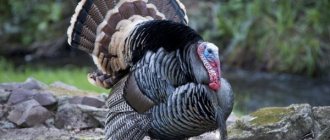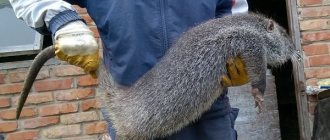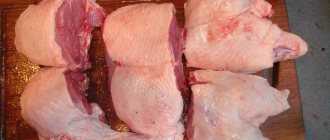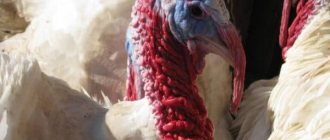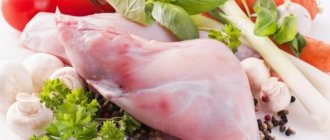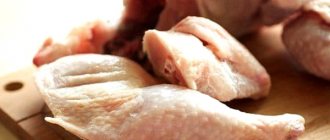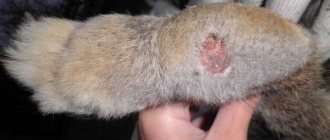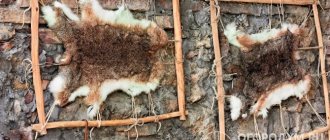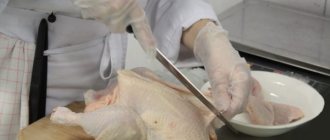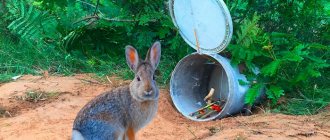Choosing a slaughtered rabbit
It will be possible to successfully cut a rabbit into portioned pieces only if the carcass itself was chosen correctly.
It is recommended to select meat according to standard rules:
- the purchased carcass must have a uniform color over the entire surface (bruises, bruises and other local color changes indicate low quality of the product). Using bad meat can not only lead to a deterioration in the taste of the final dish, but also provoke temporary dysfunction of the digestive system due to the progressive development of pathogenic microflora in the carcass;
- when choosing from a large assortment of carcasses, it is recommended to give preference to the one in which one of the legs is not skinned (this feature is considered proof that the meat being purchased is indeed rabbit meat);
- a slaughtered rabbit should not have a pungent odor, as well as visible damage to its integrity (dents, cuts, etc.);
- When purchasing a carcass, it is important to ensure that it is tightly packaged by the manufacturer (the rabbit should be on the counter in vacuum packaging).
If the purchased rabbit is placed in the manufacturer's packaging, you need to make sure that the expiration date indicated on the purchased product is not only normal, but also has a reserve.
What are the signs to determine when it’s time to slaughter an animal?
The time must be chosen depending on the goals. If you want to get tender rabbit meat, you can kill it any day after the rabbit reaches the required parameters
If it is important to obtain not only meat products, but also high-quality skins, you need to take into account some nuances. The molting stage is of great importance: if you kill a rabbit ahead of schedule, you will get a poor-quality skin, from which half of the fibers will fall out after a short time
Useful tips for choosing the most suitable time for slaughter:
- Those born in the winter months are best slaughtered at four months of age.
- If the birth occurred in the summer months, all stages of molting will be completed in November.
- You cannot slaughter vaccinated individuals if less than 30 days have passed since the procedure.
- For most breeds, the optimal time for slaughter is when the average rabbit weighs 1.6 kg.
- The best period for slaughter is from November 1 to March 15.
Place and tools for cutting at home
To make butchering a rabbit as convenient and quick as possible, you need to prepare a workplace and available tools.
This should be done according to the algorithm:
- First, you will need to remove the skin from the carcass. This step is best done by hanging the rabbit by its hind legs. The paws can be attached either to a specially installed horizontal pole (the installation of such structures is usually carried out in private homes, where animals are slaughtered and butchered on an ongoing basis), or to an ordinary thick stick fixed between two stable supports. To cut the skin you will need scissors and a sharp knife.
- After the skin is removed, the carcass must be untied from the horizontal fastening, and then a table must be prepared for further cutting and gutting of the rabbit. It is necessary to remove foreign objects from the working surface, and then wipe it with a damp cloth and let it dry. Additional tools you will need are a rag (to promptly remove dirt from the work surface), as well as a small hatchet or special scissors for cutting carcasses.
- After cutting, it is recommended to rinse the carcass thoroughly in running water, wiping it with the hard side of the sponge. This will help minimize the chance of contamination or blood remaining on the meat.
When the rabbits are slaughtered
Young rabbits from winter breeding are released for meat at 4 months of age. The time of slaughter will depend on the production orientation of the breed. If these are meat rabbits, then time is not of the essence. Fluffies weigh 3 kg already at 3 months of age.
For skin breeds, slaughter time is of great importance. Animals are allowed to eat meat only after molting has passed. You can check this very simply. If there are small hairs under the main mass of hair, it means that the shedding has not yet ended. You can also determine the end of molting by the color of the skin: if it is over, the dermis will be white under the fluff.
Skinning a rabbit
An inexperienced cook will be able to cut a rabbit into portioned pieces only if the recommended sequence of actions is strictly followed. The first step in preparing a carcass for further cutting should be skinning. This is what they call skinning a slaughtered rabbit.
This should be done like this:
- To begin with, the carcass needs to be hung upside down, fixing the animal’s legs on a horizontal stick.
- It is recommended to make one small circular incision in the area of the hock joints.
- The skin must be removed slowly, gradually exposing the areas of the paws, ears and tail.
- When most of the animal's body has been skinned, the skin will need to be removed from the thighs, cutting it between the legs. It is important not to damage the urinary canal. Otherwise, further cutting of the carcass will be extremely inconvenient and incorrect.
- Pull the skin off the carcass completely. It is recommended to help yourself with a knife while tightening. Otherwise, pieces of fat and meat will remain on the skin.
- When the skin is removed from the lower part of the animal's body to the neck, it is necessary to remove the rabbit's front paws from it, then trim it and pull it off the head.
Skinning a rabbit can be carried out as carefully as possible if high-quality tools were used during the slaughter of the animal. Otherwise, for example, due to existing damage on the carcass, separating the skin from the meat will be difficult due to the need to cut off the skin locally.
Whole carcass
If you slaughter several rabbits at the same time and do not plan to cook them right away, then you can store the carcasses in the freezer. It is best to freeze whole rabbits - this way you will have the opportunity to prepare any dish in the future, even baking the whole carcass in the oven.
Experts say that you should never wash a rabbit before freezing it. Water quickly seeps into the fibers, disrupting the structure of the product, so such rabbit meat cannot be stored for long.
Before freezing, prepare meat as follows:
- Trim off pieces of fat (they shorten the shelf life).
- Scrape off dirt with a knife.
- Clean the carcasses with a cloth towel, while removing excess moisture from the meat.
- Prepare a room for cooling the rabbits, since meat should not be placed in the freezer immediately after slaughter. The room temperature should be between 2 and 5°C.
- To ensure even cooling, tie the hind legs with rope and hang them on hooks.
- Leave for at least 5, maximum 8 hours.
- Place each carcass in separate plastic bags, preferably with a zipper. If such packaging is not available, create an artificial vacuum by letting all the air out. Quickly tie the bag with rope (thread, etc.) or secure the top with a knot.
Do not put in the freezer without packaging; the temperature in the freezer should not be lower than -18°C. In this case, rabbit meat is stored for up to 6 months.
Experienced rabbit breeders recommend lubricating the meat with vegetable oil (exclusively refined) before freezing, which will increase the shelf life and improve the external characteristics of the carcass after thawing.
Gutting
It will be possible to cut a rabbit into portioned pieces only after thoroughly gutting the animal's carcass.
It is recommended to do this according to the standard scheme:
- To begin with, the carcass must be laid on its back, on a horizontal surface, then with a sharp knife, make a longitudinal incision along the white line of the abdomen to the level of the sternum.
- Then you need to press with both hands on the thighs, pressing them towards the back, thereby crushing the groin bones of the animal.
- Remove the bladder and its tributaries from the abdominal cavity, then remove the stomach, intestines, gall bladder, and other offal one by one. It is extremely important when removing the viscera to ensure that the bladder and gallbladder remain intact. When the contents of these organs leak out, the rabbit meat will absorb a sharp, unpleasant odor, which will be impossible to get rid of later.
It is permissible to gut the carcass by placing it in a vertical position. This method is used by those who already have experience in butchering a rabbit, and therefore know the location of the animal’s internal organs. This method is not suitable for inexperienced cooks, since when the rabbit is secured by the legs, the internal cavity of its abdomen remains closed, which means that careful removal of the organs becomes difficult. Due to improper positioning of the carcass, unintentional damage to the gallbladder or bladder usually occurs.
Possible problems
Leaving too early is a cause for concern. Experienced farmers understand that if young rabbits that are not yet strong enough get out of the nest, they have too little milk. If you have such a situation, you need to assess the condition of the rabbit:
- The female's nipples are examined and inflammation can be detected.
- As a test, you can easily squeeze one and see if milk comes out.
Females who receive balanced food give a lot of milk. On average, a female rabbit feeds 8 rabbits, but only if she has enough variety of food. If the offspring is larger, then the strongest animals will receive most of the milk, and the rest will eat the rest. They remain hungry and leave the queen cell too early.
So, if the baby rabbits leave the nest early, they are malnourished. This problem is solved in two ways:
- Weak rabbits are transferred to a dairy female with a small litter.
- Babies are fed kitten formula or goat's milk. One week old rabbit is fed 5-10 ml of milk per day, when it is 2 weeks old - 10-15 ml per day, at 3 weeks - 15-20 ml of the mixture.
Gradually they are accustomed to the usual food that is given to adult livestock. It’s good if it is possible to feed the young rabbits feed.
Step-by-step instructions for butchering a rabbit
It is necessary to choose instructions for butchering a rabbit taking into account how the final dish should turn out - uniform consistency, pieces, minced meat, and so on.
In portions for frying
It is recommended to cut the rabbit into portions for further frying as follows:
- The pre-gutted carcass must be washed in running water and then dried with paper napkins or towels.
- Using your hands, remove any remaining film, pieces of fat or skin from the surface of the meat.
- Using a sharp knife, remove the front legs.
- Place the rabbit on its side, then lightly press on the end of the paw, thus achieving protrusion of the shoulder. Make an incision in the shoulder area along the contour of the protrusion towards the neck part of the carcass.
- Place the knife in the pelvic area, and then, moving the tool towards the neck along the spine, cut off the fillet of the carcass. The cut meat should not be cut into several medium-sized pieces.
- Place the knife inside the pelvic cavity, and then make an incision through the hip joint and separate the hind legs.
How to butcher a rabbit - step-by-step instructions. - Divide the carcass into 2 halves using an incision in the lumbar region. During the eruption of tendons, it is necessary to press the processes of the bones, thus provoking their fractures.
- Separate the meat from the belly by making 2 side cuts.
- Separate the meat from the back of the carcass.
- Cut the meat from the breastbone from the inside, then chop the fillet into several medium-sized pieces.
- Before frying, rabbit meat should be rinsed again and dried with paper towels.
On fillet for barbecue
You can cut the rabbit into portions for further preparation of barbecue using:
| Tool | Possible alternative |
| Sharp knife | culinary hatchet |
| Cutting boards | — |
| Scissors designed for cutting bone tissue | culinary hatchet |
| Disposable latex gloves | Optional. Using gloves you can significantly reduce the likelihood of injury from bone and tendon scraps. |
The algorithm for cutting a carcass for barbecue should look like this:
- Rinse the pre-gutted carcass thoroughly, then dry it with paper towels or napkins.
- Place the carcass on a cutting board, back side up.
- Cut off the hind legs and thigh area. It is recommended to use a sharp knife, and when reaching the bone part, you should replace it with culinary scissors.
- Place the knife in the hip joint area, then cut off the hind legs. If the paws are too large, then it is permissible to divide them into 2 parts for the convenience of further cutting.
- Remove the front legs using a knife. If these limbs are also quite large, it is recommended to similarly divide them into 2 parts.
- Place the remaining carcass on a cutting board, then make small cuts in the spine area, placing them at a distance of 2-4 cm.
- Separate the fillet along the cut you made, then bite the bone using culinary scissors.
Cut the separated fillet into small pieces, then rinse, dry and thread onto skewers for further frying.
For minced meat
It is recommended to cut the rabbit into pieces for further preparation of minced meat as follows:
- With the rabbit on a cutting board, cut off the hind legs along the joint area. This must be done quickly, since in the case of numerous breaks the bones will shatter, after which it will be extremely difficult to remove them from the meat. If the hind legs are very large, then when cutting it is recommended to divide them into 2 more halves.
- Guide the knife along the line of the tendons and their joints and cut off the front legs of the rabbit.
- With the tip of the knife on the lower back of the slaughtered animal, it is necessary to cut the meat from the ribs and back of the carcass.
- Provided that the carcass has not been previously gutted, at this stage it is recommended to carefully remove offal from its internal cavity - heart, liver, kidneys, and so on.
- Using a knife, make an incision in the rabbit's lumbar region, and then break the bones with a confident movement of the hand.
- If the rabbit being butchered was large, it is recommended to cut the fillet from the neck of the animal with the tip of a knife.
- The remaining part of the carcass (breastbone) must be laid out on a board, and then cut into 4 pieces using culinary scissors. Next, use a knife or scissors to carefully remove the fillet from the bones and ribs.
- The cut rabbit meat must be washed, dried with paper, and then passed through a meat grinder with onions and spices.
For the roll
The portioned pieces obtained by butchering the rabbit will also be needed when preparing the meatloaf.
The algorithm for separating meat from bones in this case will be as follows:
- Place the carcass on a cutting board, then use a sharp knife to cut off the top layer of meat, leaving the outer shell of the product intact.
- The whole layer must be washed in running water, and then dried with paper napkins and rubbed with spices on both sides. The most commonly used ingredients in rabbit meatloaf are salt, pepper, chili powder, oregano, garlic and parsley.
- The meat remaining on the bones must be cut off in any convenient way, and then chopped as finely as possible for further use in the work process.
According to the classic version of preparing such a dish, the cook follows:
- You need to finely chop 100 g of turkey.
- Next, the chopped poultry should be mixed with small pieces of rabbit meat.
- It is recommended to place a layer of rabbit fillet on foil greased with a small amount of vegetable oil, and then sprinkle it with 20 g of gelatin.
- Place the meat mixture on the gelatin, season it, then pour in 30 ml of dry white wine and pack tightly in foil, after rolling the fillet into a roll.
- The optimal cooking time for the dish in question is 3 hours in a water bath in an oven preheated to 70 degrees Celsius.
For fricassee
To prepare rabbit fricassee, it is recommended to cut the meat according to a strictly defined algorithm:
- Having made a longitudinal incision, it is necessary to remove the kidneys from the rabbit carcass, and then fill them with running water and leave to soak for 3-4 hours.
- Using a knife and kitchen scissors, you need to separate the limbs from the carcass, and then cut the meat from the bones in any convenient way.
- The cut meat must be washed, and then, after drying, cut into small pieces.
- It is recommended to rinse the bare bones, add water and boil the broth on them.
- While the meat is being prepared, you need to peel the onion and 2 medium-sized carrots. After this, the vegetables should be chopped (finely chop the onion and grate the carrots) and fry in a frying pan.
- Previously chopped rabbit fillet must be rolled in a salted breading mixture, then fried until golden brown on both sides in a hot frying pan with a minimum amount of vegetable oil.
- The fried vegetables should be placed with the meat, then mixed, seasoned and poured with the broth that has been cooked by this time.
- After 20 min. When stewing a rabbit, finely chopped, pre-soaked animal kidneys should be added to the main mass.
- The optimal cooking time at the final stage is 30 minutes. It is recommended to stir fricassee at least once every 3-5 minutes.
Preparatory work
Before a rabbit is slaughtered in home farming, it is fed a starvation diet. In 12 hours, the animal’s gastric tract will be almost completely emptied. This method helps simplify bleeding and evisceration.
The skin of an individual intended for slaughter should be cleaned with a special brush. First you need to prepare a well-sharpened knife, as well as a crowbar or hammer. A living rabbit is taken with one hand by the hind legs and fixed well, turning it upside down. You should hold the rabbit in this position for some time until it calms down.
With a stick or hammer you need to strike accurately on the back of the head, behind the ears. The rabbit dies instantly from a rupture of the spinal cord. The correctness of the blow will be indicated by the appearance of streams of blood from the nose and ears. Then the carcass is hung by the hind legs on special hooks and cuts are made in the area of the new passages or the eyeball is removed.
There is a certain scheme for slaughtering rabbits. They do this in several ways:
- you can pierce the skull with a hammer;
- twist your neck, clasping the area of your head from the back of the head to the chin with the fingers of your right hand and making a sharp movement to the side;
- the most humane method is slaughter by electric charge.
To have a more accurate idea, it makes sense to watch a video on how to slaughter and butcher a rabbit. When slaughtering, it is very important not to damage the skin and remove it correctly. Most often, the skin is removed using the stocking method, which you can also learn about from the video.
Express cutting method
The easiest and fastest way to disassemble a rabbit carcass at home is:
- First you need to thoroughly wash the meat, dry it, and then place it on a cutting board.
- Using a knife, cut off the animal's limbs through the joints.
- After turning the carcass over, you need to make 2 identical deep cuts along the bottom line of the ribs on both sides.
- Having placed a knife or a culinary hatchet across the rabbit carcass, you need to cut it into 2 parts along the last rib to the spinal column area.
- It is recommended to fold the carcass in half, and then make another cut along the lower rib to simplify the process of removing meat from the bones.
- Next, you need to remove the fillet from the bones with your hands. Where the meat is difficult to remove, you can use a thin, sharp knife.
- At the final stage of the work process, you need to cut off the forelimbs of the slaughtered rabbit by placing the knife at the bottom of the carcass and slowly moving it along the contour.
- The resulting fillet should be washed in running water, and then, after allowing it to dry on its own, use it in further cooking. To preserve the nutritional value of rabbit meat, it is recommended to avoid long-term storage, regardless of the conditions created for this purpose (ideally, meat should be cooked immediately after cutting).
Leather processing
Every farmer strives to make his farm waste-free. As you know, rabbits are not only tasty dietary meat, but also valuable fur. However, in order to use it, you need to learn how to properly tan the skins. The quality of the skin and the cutting of a rabbit are interrelated concepts.
First, remove any remaining subcutaneous fat and flesh. For this you will need a special blank. The blank is a board in the shape of the letter A with a movable horizontal crossbar. The skin is scraped out, holding the knife at an angle of 90° to the skin. After scraping, the skin is pulled onto a blank and dried. Place the skin fur side down.
The lower part is carefully straightened and secured so that it does not curl up when drying. The frame with the skin must be placed in a well-ventilated, dry area. Do not allow it to dry out, otherwise the skin will become brittle and its quality will be significantly reduced. In a damp, cold room, the skins will quickly become moldy and spoil.
The skins are then soaked in a disinfectant solution. Before the skin is ready for industrial use, it must go through several stages of processing.
Useful tips
To make the process of butchering a rabbit as simple and fast as possible, the cook should organize the work process in accordance with general recommendations:
- Despite the low frequency of using a kitchen hatchet (or a professional butcher knife), it is recommended to use it to cut and gut a rabbit. This tool will not only allow you to break bones and crush their tight joints (it is also permissible to use a cleaver for this purpose), but also cut off the fat layer, film, and also carefully separate the fillet from the bone part of the carcass;
- for cutting and gutting a rabbit, it is recommended to use a board with a replaceable silicone coating or a surface made of tempered glass (wood and plastic, most often used in the production of cutting boards, quickly absorb blood and moisture, but are difficult to wash, which can provoke the growth of pathogenic microflora, which will later end up on food products);
- If the cook considers it necessary to freeze cut rabbit meat, it is recommended to package the tenderloins separately. This is due to the significant difference in the heat treatment time of liver and meat parts.
Portioned pieces, provided that the cook managed to carefully cut up the slaughtered rabbit, can be used in preparing various dishes (rolls, cutlets, casseroles, etc.). Before separating meat from bones, it is necessary not only to decide on the format of the final type of rabbit meat (minced meat, layer or portioned pieces), but also to study the structure of the animal’s body. This will help minimize the risk of excessive crushing of bones and tendons.
How to properly process the skin
If you managed to properly cut the rabbit carcass, then it’s time to start skinning. It is thoroughly degreased, that is, freed from fat and meat pieces. If the rabbit was butchered not by a beginner, but by an experienced rabbit breeder, then after cutting there will be no traces of meat left on the skin
In short, everything depends on the accuracy and care with which the work was done
To properly degrease the skin, you will need a blank made of dry wood. The skin is pulled over the blank, with the fur inside, and all excess (pieces of meat, fat, etc.) is removed.
If degreasing has been accomplished, the skin is placed on a pre-prepared frame that resembles the letter “A”. The product is threaded into the frame, the fur should be at the bottom. To prevent the skin from shrinking and shrinking during drying, its edges are secured to a frame.
It is better to dry the skin in a special room at 20–35 degrees. If several skins are being dried, then the frames should be placed at a certain distance, equal to 1.5 or more meters from the battery or heaters. There should be more than 10 cm between the frames themselves, that is, they cannot stand closely.
After the skins are completely dried, they are stacked on top of each other. Now they can be sold as a finished product. To make any product from rabbit skin, it must be carefully processed, trimmed and washed.
Proper living conditions for animals, a nutritious diet, regular attention and care will allow you to raise good rabbits that will produce high-quality and healthy offspring. And this, in turn, contributes to the production of skins and natural meat that can be boiled, fried, stewed
To know how to properly cut a rabbit, you should follow the rules described above.
If healthy, high-quality individuals were chosen for slaughter, then their meat will be tasty and healthy. The skill of slaughtering an animal will allow you to have a good income from selling meat and skins. For experienced rabbit breeders, killing and gutting animals is not difficult, so all this is done quickly and efficiently and leads to a good product.
Preparation for slaughter
Before slaughter, animals are not fed for 12 hours; they are only allowed to give them water. This measure will avoid contamination of wool during slaughter. Shortly before the killing procedure, the pets' fur is checked for tangles and dirt. If necessary, wash contaminated areas with warm water. Using a brush, the fur is tidied up, getting rid of lost hairs.
Attention! Before slaughter, animals are examined by a veterinary service employee if their meat is intended for sale and not for personal use.
The farmer needs to prepare tools for slaughter. They can be different, depending on the chosen method of killing animals:
- a stick with one end wrapped in rubber;
- electrodes;
- syringe;
- pin-needle.
Rabbit slaughter
In addition to the listed tools, you will need several knives - one for bleeding, another for skinning, and a stick-spacer for hanging the animal. You also need to prepare containers for collecting blood and internal organs, a basin with warm water, soap and a towel.
Necessary equipment
In order not to delay the cutting process, you must immediately prepare all the necessary items. It is recommended to take the following equipment:
- Sharp knife. There are no specific rules on what size a knife should be. You should take the one that the cutter likes best, the main thing is that it should be sharp.
- Cutting board. It is recommended to use a plastic cutting board on which only raw meat products are cut. If you don’t have one, you can use a regular wooden one.
- Kitchen scissors. They are necessary for cutting ribs.
- Latex gloves. They are needed to avoid damaging your hands on the bones when cutting a carcass.
- Hatchet. Needed only if culinary scissors cannot cut the bone, its use is highly undesirable.
Some recommendations
After the rabbit has been killed and dressed, nothing needs to be done with it for 12 hours. The meat must be “ripened” in a cool place; it should not be frozen either. Only after 12 hours does the taste of the meat fully develop, and its taste improves significantly.
As for freezing, professionals do not recommend freezing it at all, since the taste and beneficial properties are lost. This is due to the fact that the liquid contained in the meat expands when frozen and tears the fibers, and when defrosted, most of the liquid is lost, which affects its juiciness.
Features of rabbit meat
Rabbit meat is highly valued due to its low fat content and easy digestibility. It can be included in the diet of young children as the first meat food. Let's consider the advantages of the product:
- Low calorie content - 183 kcal/100 g. Those wishing to lose weight are recommended to include rabbit meat in the menu, as it consists of 21% protein and contains almost no fat.
- Delicate structure and pleasant taste. It’s no wonder that rabbit dishes are served in the best restaurants.
- The product does not cause allergies.
- It contains essential amino acids that a person can only obtain from food.
- Rabbit meat is 90% digestible, unlike other types of meat.
